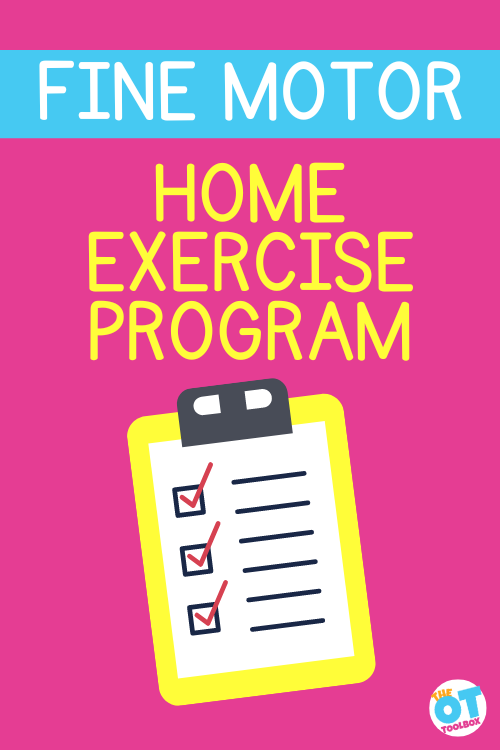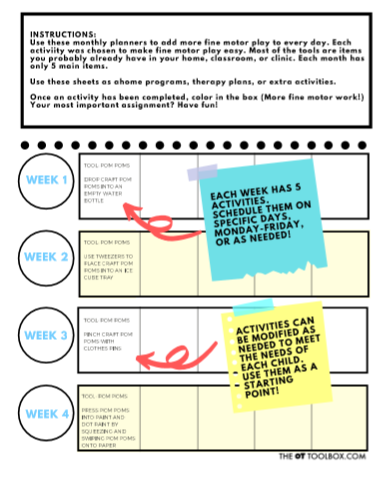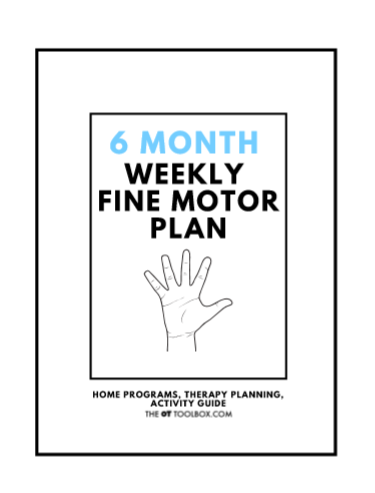One thing that therapy providers often come across is the the issue of needing a fine motor home exercise program to support the skills that are targeted in therapy sessions. The fact is that 30 minutes of therapy intervention, once a week, is not likely to improve dramatic changes. The need for a fine motor home exercise program is even more necessary for an area such as grasp strength and finger strength.
Get your child’s fine motor skills moving with this easy, 6 month fine motor exercise program! All you need are common household items to get 6 months worth of daily fine motor activities. Your child will love seeing the progress they make each day and you’ll be in awe of the accomplishments they can make with just a few simple items.

Fine Motor home Exercise Program for Kids Using Household Items
For kids, fine motor skills are essential to everyday life. From tying shoelaces to writing neatly with a pencil, these activities require control and coordination of the small muscles in their hands and fingers.
Unfortunately, many children struggle with developing their fine motor skills and can lag behind their peers. This resource on fine motor milestones has a list of ages aligned with fine motor developmental progression.
To help your young ones develop these important skills, I’d like to share a 6 month fine motor exercise program for kids that can be completed with simple household items! This is a great exercise program for working on hand strength, pencil grasp, or carrying over therapy goals at home.
So often the fine motor skills needed at school need extra work at home, and this home exercise plan will do the job, in a fun way. These ideas are fun and engaging each day…and aren’t your typical grasp exercises.
Your children will need some basic supplies for this program:
- Craft pom poms (or a bag of cotton balls)
- Paper clips
- Play Dough
- Playing cards
- Clothes pins
- Pipe cleaners
- Slime
- Tweezers
- Bottle caps
- Yarn or string
- Coins
- Foil
- Tissue paper
- Paper cups
- Rubber bands
- Dry pasta
- Mini erasers
- Tape
- Blocks
- Golf tees
- Chalk
- Paint
- Craft sticks
- Googly eyes
- Toothpicks (Also use them with our toothpick activity to build precision skills)
- Squeeze glue
- Spray bottle
- Cardboard scraps
We selected these items because most therapy providers have them in their therapy bag or available in a therapy clinic. For those working in teletherapy, they are common enough items that families will have them in the home and can pull them out for the child to use in their online therapy session.
Of course, you could always substitute the materials with different supplies. Or, you could write in your own home program tasks on the blank page.
And, when using our fine motor program for a home exercise program, it’s possible that the family will have these items available. Some therapy clinics or companies may even want to offer a small kit of these items along with the home program instructions for the children receiving therapy services.
All of these items should be available in your home or from a local dollar store. With these items, you can provide your children with a variety of activities designed to enhance their fine motor development.
The great thing about this 6-month program is that it’s easy to customize the activities to the age level and skill level of the child. For example, younger children may require more guidance and assistance with the activities while older children may be able to complete the activities independently.

Here is a sample of the types of activities you can do with your child each day:
• Drop craft pom poms into an empty water bottle- This skill targets open thumb web space, eye hand coordination, bilateral coordination, tripod grasp, pincer grasp, separation of the sides of the hand, finger isolation, and more.
• Connect paper clips to make chains. Then use the chain lengths to create letters on a table top. This activity targets eye-hand coordination, separation of the sides of the hand, hand strength, finger dexterity, pinch strength, motor planning, visual motor skills, and more.
• Make a play dough pie. Pinch the crust. Use scissors to cut the pie into slices. This activity targets several areas: hand strength, motor planning, pinch strength, bilateral coordination, motor planning, separation of the sides of the hand, and more.
• Clip clothes pins onto a string hanging from under a table. This activity works on many areas: core strength and stability and upper arm strength, which are both necessary pre-requisites for fine motor control and precision. The activity also targets intrinsic muscle strengthening, motor planning, eye-hand coordination, grasp strength, and more.
This is just five of the activities in the plan. Users can work through the activities (presented Monday-Friday) using a different fine motor tool each day. This is designed to keep the tasks fun and engaging while also targeting a variety of skills. Every child we’ve used this strategy with has looked forward to the day’s activity because it’s fun and new!
Click here to get your copy of the Weekly Fine Motor Home Exercise Plan.
Tips for Making Fine Motor Home Exercises More Fun
To keep your child engaged in the activities, here are some tips to make them more fun and exciting! Read about hand strengthening for more insight.
• Create a competition – Create a game out of the activities by allowing your child to compete against you or another family member. For example, have a race to see who can thread the most straws onto the string in one minute.
• Add a timer – Adding a timer helps to ensure that the activities are still challenging. For example, give your child one minute to thread the straws or two minutes to pick up the cotton balls with the toothpick.
• Incorporate music – Music can help to make the activities more fun and enjoyable. For example, play a song while your child is picking up the cotton balls or cutting out shapes with the scissors.
• Involve the whole family – Invite the whole family to participate in the activities. You can have a contest to see who can thread the most straws onto the string or who can cut out the most shapes with the scissors. This is a great way to get everyone involved and keep the activities fun!
Use the daily challenges in the Weekly Fine Motor Home Exercise Plan to create games, family events, and build those motor skills!
Why Use a Fine Motor Home Exercise Program
In addition to making the activities more fun, there are also many benefits to this 6-month fine motor exercise program for kids. When your child engages in the activities, they are developing important skills such as hand-eye coordination, manual dexterity, and visual-spatial awareness.
These skills are essential for everyday tasks such as writing and tying shoelaces. The activities also help to strengthen their fine motor muscles which can help to improve their handwriting and drawing abilities.
Another great benefit of this program is that it can be done anywhere! All you need are 6 household items and you can provide your child with 6 months worth of daily fine motor activities. This makes it easy to fit in time for practice no matter how busy your schedule is.
With these activities, you can help your child develop their fine motor skills in a fun and engaging way. So, grab some cotton balls/craft pom poms, paper clips, play dough, deck of cards, and clothes pins, get your copy of the Weekly Fine Motor Plan, and start working on those fine motor skills today!
With this easy 6 month fine motor program, you can give your child the opportunity to experience the world through movement, exploration and play. Plus, it’s an economical way to provide them with a creative outlet and help them to develop their physical abilities. Don’t wait another minute – get started today and unleash the potential of your child’s motor skills!
NEW ITEMS ADDED. This purchase now includes:
- SIX MONTH Weekly Fine Motor Program
- Clothes Pin Exercise Cards- Use in games, home programs, brain breaks, fine motor challenges, and more.
- Clothes Pin and Paper Clip Activity Cards- Print off the activity cards and challenge eye-hand coordination, precision, dexterity, bilateral coordination, and hand strength.
- Play Dough Letter Match-Ups- These upper and lower case letter cards are mini play dough mats to challenge hand strength and coordination skills as well as hands-on, sensory-based letter formation skills.
Grab your copy of the Weekly Fine Motor Plan (and get the extra motor activities included!)







